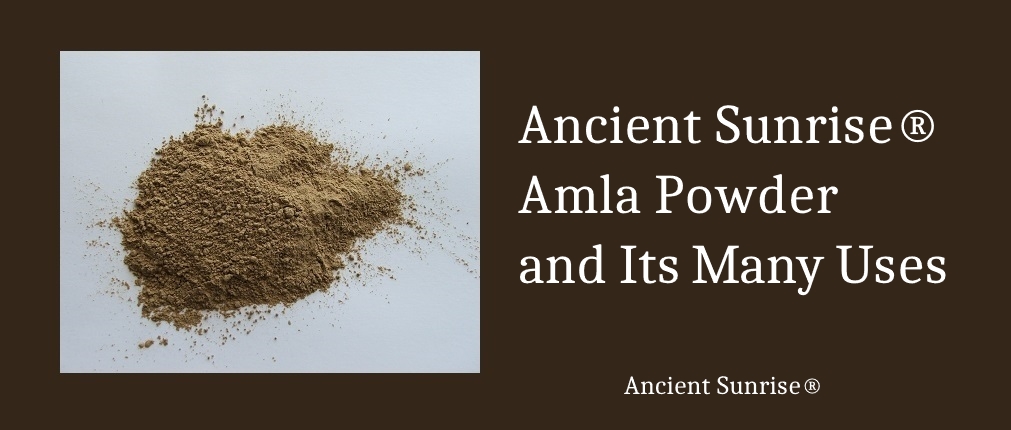
Amla (emblica officinalis) is also known as Indian Gooseberry. It is both eaten and used in hair and skin care products in South Asia. To create amla powder, the fruit is dried, ground, and sifted. Ancient Sunrise® Amla powder can be used as an acid to dye-release henna and cassia mixes and to prevent loss of curl pattern, on its own as a hair treatment, and on the skin as a facial.
In a henna and/or cassia mix that involve indigo, amla lends ash tones to the resulting color. It helps to maintain a person’s natural curl pattern, which can loosen with repeated henna applications. Amla allows more indigo dye to enter the hair, for richer, darker brunettes.
Amla’s natural acids temporarily snap the hydrogen bonds in the hair, allowing the strands to be reshaped. Using amla as a treatment on its own can add body and wave to the hair. This same effect can be utilized for the skin. This powder helps to loosen dead skin cells on the surface and exfoliate them away, leaving clearer, brighter, and tighter skin.
Ancient Sunrise® amla powder is tested by our suppliers to ensure it is free of adulterants. We also run our powder under a microscope to check for any irregularities. It has a pH level of 3.5, making it an effective acid for dye release. It it gentle enough to use directly on skin for short periods of time.
Amla for Neutral/Ash Mixes and Better Brunettes
Amla contains gallic acid, ellagic acid, and ascorbic acid. Gallic acid pushes henna and cassia’s dye molecules toward ash tones, leading to cooler hair color results. This is useful for those who do not want red tones in their brunette mixes, or want a more neutral blonde result.
A mix with just henna and amla will result in a browner or cooler red, with less orange or copper tones. A mix with just cassia and amla will result in a more neutral, “wheat” blonde on light and graying hair, as opposed to a yellow blonde.
To use amla powder to neutralize red and yellow tones, mix 25g (just under three tablespoons) with every 100g henna and/or cassia. Mix the powders with distilled water and dye-release as normal. There is no need for additional acid powders or fruit juice.
If you are adding indigo to your mix, do so as you would normally, mixing Ancient Sunrise® indigo powder with distilled water and combining the pastes immediately before application.
With mixes containing indigo, the result will be a cooler, deeper brunette. This is especially useful for people who want minimal warm tones in their hair, and those who notice that the indigo fades from their hair over time, leaving a red tone. Amla allows more indigo to bind effectively with the hair.
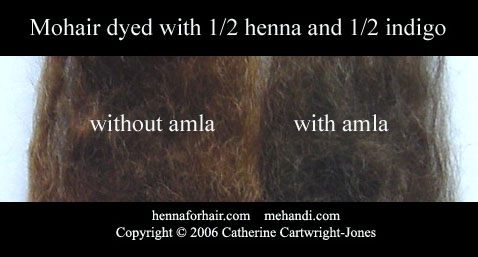
Amla is not a dye, and will not affect the color of a person’s hair if used on its own. It merely aids in indigo uptake, as well as shifting the resulting color of henna and cassia dyes.
The Ancient Sunrise® Henna for Hair kits in Cool Brunette and Cool Dark Brunette contain pre-measured portions of henna, indigo, and amla for easy mixing and great results.
Amla for Curls and Waves
When henna’s dye molecule binds with the outer keratin layers of the hair, it smooths frizzy, damaged hair and reinforces thin, weak hair. The added molecules also make the hair heavier and thicker. For those with a natural curl pattern, this can mean looser curls. Some who find their curls unruly or unmanageable take advantage of this effect. However, many wish to keep their curls. Adding amla to a henna mix helps to maintain the natural curl pattern.
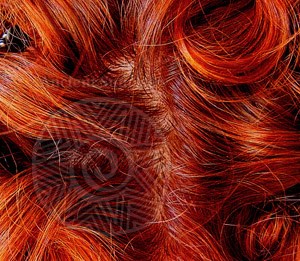
This can be done one of two ways. If you are also looking to mute red tones or achieve a deeper brunette, use Ancient Sunrise® amla powder to dye release your mix as explained above. If you wish to keep a brighter tone, dye-release your mix with your choice of acid, then mix 25g of amla into a paste, and stir this into your henna or cassia just before application. This will protect your curls without neutralizing henna and/or cassia’s brighter tones.
To add bounce and body to your hair, use amla on its own as a hair treatment mixed with Clarity Cassia. The following section will cover this.
Amla as a Conditioning Treatment
Amla can be used with Clarity Cassia to add bounce and body to the hair, to clear the scalp of dead skin, and to balance oily scalps. Amla’s acids cause the bonds in the hair to temporarily loosen, making it possible to temporarily reshape them. The acids also help to exfoliate skin and break down excess oil, keeping the scalp healthy and the pores clear.
Mix a paste of amla powder, cassia powder and distilled water. 25g of amla is needed for every 100g of cassia. The amount total will be dependent on the thickness and length of your hair. Apply the paste throughout clean hair and wrap with plastic, leaving it in for for an hour. Rinse, massaging the scalp, towel dry, and set your damp hair in curls or a braid and allow it to air dry.
Those who have normally very dry scalp and hair, or those who are sensitive to higher levels of ascorbic acid may want to use this technique sparingly or for a shorter amount of time to avoid itching and dryness. One can also use a little bit of oil or serum on the scalp if it feels too dry after the amla treatment.
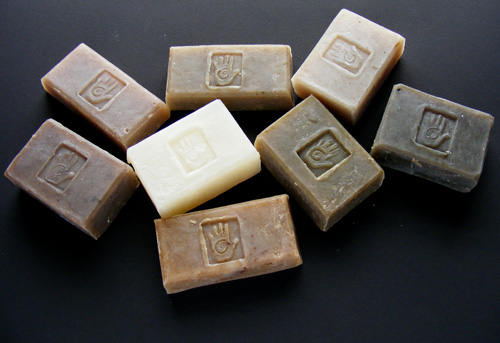
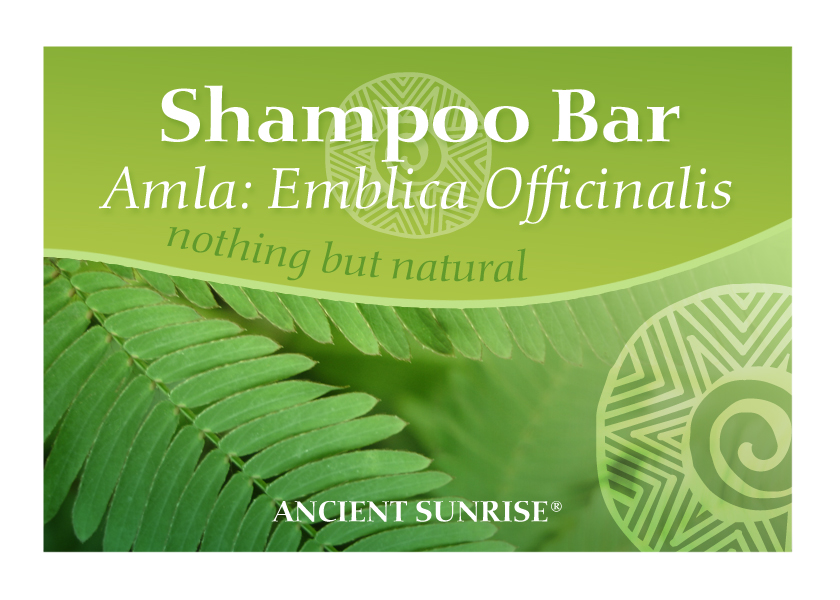
Amla as a Facial
High in vitamin C (ascorbic acid), amla paste makes a great facial treatment. It exfoliates dead skin cells, encouraging cell turn-over, and clears away excess oil. It leaves the skin tighter and brighter. Those with acne may find that a regular amla facial helps to lessen and prevent breakouts, and fade hyperpigmentation that comes with scarring. Over time, the complexion becomes brighter and more even, and the skin’s texture is smoother.
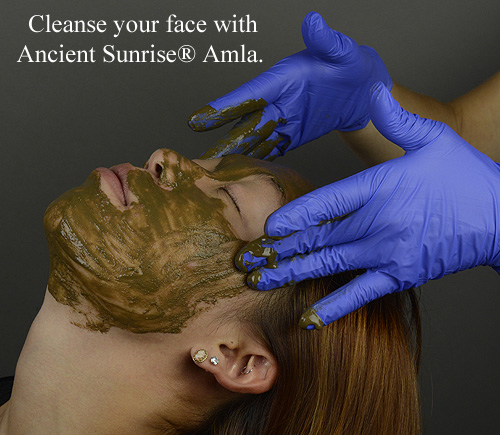
Mix 1-2 teaspoons of amla powder with enough warm water to create a paste. Massage the paste over clean skin, avoiding the eyes. Leave it on for 3-5 minutes. Rinse, pat dry, and moisturize. This can be used once or twice a week. Vitamin C can increase UV sensitivity for some; if this is the case for you, make sure to use an SPF.
If you have further questions about how to use Ancient Sunrise® amla powder, feel free to comment below or contact Customer Service via email, chat, or phone.
